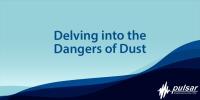 Add My Company
Add My Company
Sign In
Delving into the Dangers of Dust
10-09-2021

There’s no question that we understand that contamination is a bad thing, but do we really understand what it means daily for individuals and organisations?
Whilst contamination comes in various forms, there are some broad categories that we can use to make understanding the dangers easier.
One of the most important forms of contamination in the workplace and the most hazardous form to health is dust.
This blog discusses the different categories of dust that can cause serious and long-term health problems within your workforce.
What is dust?
Dust in the workplace is currently one of the single most significant health and safety issues and can be a problem in any industry. Thousands of people each year suffer adverse health effects due to workplace exposure, and this exposure can lead to a number of health problems, including:
Occupational Asthma
Chronic Obstructive Pulmonary Disease (COPD)
Pneumoconiosis
Cancer
Dust can be a subtle contaminate, with the most hazardous particles often being invisible to the human eye and with the health effects only becoming apparent many years later.
Flour Dust
It’s easy to underestimate the hazards related to flour dust. Approximately 100,000 people are potentially exposed to it every day in the UK baking sector, usually with no obvious side effects.
When inhaled, flour dust can trigger an irreversible allergic reaction in the respiratory system, also known as Occupational Asthma, with symptoms such as wheezing, shortness of breath, chest tightness and eye irritation.
Fortunately, there are methods of control available, ranging from reducing the production of dust, such as dust reducing handling methods, the provision of appropriate respiratory protection, and methods of reducing the amount of dust in the air.
Asbestos
Even though the use of asbestos-containing materials has been banned since 1999, asbestos still poses a severe threat, especially to tradespeople.
Regardless of the improvements in managing asbestos, it still kills 20 tradespeople (on average) a week due to the long period between exposure and the onset of diseases.
Working with asbestos can pose many dangers, and following the Control of Asbestos Regulations 2012, most work can only be carried out by HSE licensed contractors.
Wood
There’s a reason that many carpenters and joiners are four times more likely to suffer from asthma compared with other UK workers. Exposure to wood dust, especially hardwood dust, which is associated with nasal cancer, can result in serious health problems.
According to The Control of Substances Hazardous to Health (COSHH) Regulations 2002, you are required to protect workers from the hazards of wood dust, and Workplace Exposure Limits (WELs) are in place to make this easier.
There are several methods of control, including:
Dust extraction, also known as local exhaust ventilation or LEV
Using PPE/RPE for short-term protection
Concrete/Silica
The potential risk of concrete in the construction industry is often underestimated. High levels of concrete dust are usually produced when cement is being handled, whether that’s when you’re emptying or disposing of bags or scabbling or cutting concrete.
Long-term exposure to this type of dust cause occupational asthma, but exposure to the Respirable Crystalline Silica (RCS) found in concrete and mortar can lead to the development of silicosis or scarring of the lungs, which often results in a lack of lung function and even cancer.
Breathing in RCS can also lead to COPD.
One possible means of mitigation would be the practice of having mobile shower units on site, which can ensure workers can remove any lingering dust at the end of their shift.
The XD One Personal Dust Monitor
The XD One is a new, wearable, self-contained personal dust monitoring device that allows you to protect your employees from the hazards of dust in the workplace before it’s too late.
Easy to use, accurate, durable and manufactured in the UK, this device delivers continuous, real-time detection of harmful particulates in even the harshest of conditions and can help you act before longer-term conditions can cause too much harm.
The potential sources of contamination may not always be obvious, but it’s essential that as an employer in an industry where dust could be a serious issue, you take care to ensure that all practicable methods of control are in place to protect the health of yourself, your employees and the public.
For more information on Delving into the Dangers of Dust talk to Pulsar Instruments plc
Enquire Now
List your company on FindTheNeedle.
